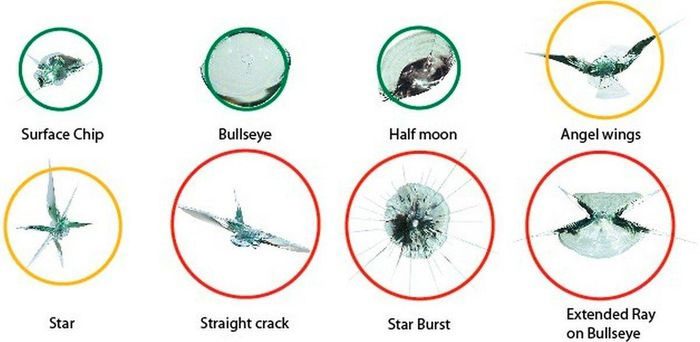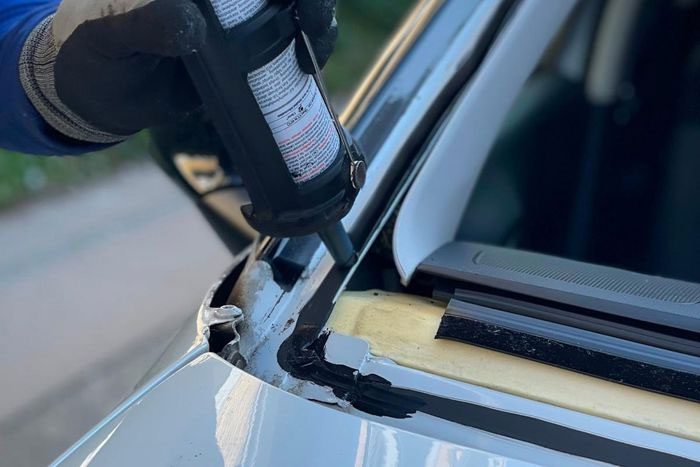Debris and other fragments on the road are the main causes of scratches and cracks on car windshields. No matter how careful you are, you cannot completely avoid these unfortunate situations. These cracks not only detract from the aesthetic appeal but also pose potential safety risks while driving.
In fact, knowing how to repair a cracked or chipped windshield can save you time and money. Addressing damage as quickly as possible is crucial for your safety and that of other road users. However, we recommend that you take your vehicle to professional repair shops for an assessment before deciding to repair or replace the windshield.
Did you know that windshields provide up to 40% of the structural integrity for a car’s roof? The support that the windshield offers in preventing the roof from collapsing during a rollover is vital for overall safety – for this reason, it is important to have a high-quality windshield that is structurally sound and undamaged.
Types of Windshield Damage
There are many different types of damage that can occur to a windshield from various causes. Below are a few typical cracks found on windshields.

Some typical cracks on windshields ranging from low to high risk.
- Surface Crack: Sometimes small stones hitting your windshield may only chip a small piece of glass, leaving an almost negligible mark. This is the most common type and may seem insignificant but can lead to greater damage later on.
- Stress Crack: Stress cracks can occur due to extreme temperature changes. These cracks are usually long and often start at the edge of the windshield. If you are dealing with ice on the windshield that causes it to expand and contract as temperatures rise, a small crack can easily spread into a larger one.
- Floating Crack: Floating cracks form around the center of the windshield or at least 5 cm from the outer edge. Since windshields are more vulnerable in the center, floating cracks can quickly expand.
- Edge Crack: These cracks begin from or around the edges of the windshield. Edge cracks can spread across the windshield and are often very convoluted.
- Bullseye: A bullseye break can occur from a spherical fragment, like a small stone, hitting the windshield. They resemble a crater in the glass and can be quite deep.
- Half-Moon: A half-moon crack also occurs from a circular object striking the windshield while you are driving. These cracks typically form around semi-circular debris but are still unsightly and can obstruct visibility while affecting the structural integrity of the windshield.
- Starburst: Starburst cracks consist of small cracks radiating like a star. These cracks can spread and evolve into larger windshield cracks if not repaired in the future.
Should You Repair a Small Crack in Your Windshield?
Small cracks usually do not cause immediate problems, but over time, they can affect driving safety. The vehicle body must bend while in motion, placing pressure on the windshield. The same can happen when your car is exposed to temperature changes. In cold weather, outside frost and rising heat from the cabin can cause expansion and contraction, easily leading to cracks in the windshield.

Replacement is only truly necessary when the glass has shattered too much.
Therefore, car owners facing these issues should repair or replace as soon as possible to avoid larger cracks in the future.
When you see multiple small cracks on your windshield, many people will request a complete replacement. However, this may not be the best solution. Replacement is only truly necessary when the glass has shattered significantly. If the length of the crack is less than 15 cm, a glass repair technique will be more successful. The larger the crack, the lower the chances of successful repair.
Of course, if the damage is so extensive that the windshield is shattered more than just damaged, you cannot repair it and will need to replace it. Here’s a quick guide to know when you should replace instead of attempting to repair the glass:
- If the damage reduces your visibility in any way.
- If the crack is longer than 15 cm or starburst/bullseye cracks larger than 3 inches.
- If the damage is near a corner or edge of the windshield.
- If the crack has a certain depth.
Giant Cobra rises up “standing” like a person creating a terrifying scene
Why do scientists believe that star HD 140283 existed before the universe was formed?
Why is there 1,600 tons of gold sunk at the bottom of Lake Baikal that no one has recovered?



















































